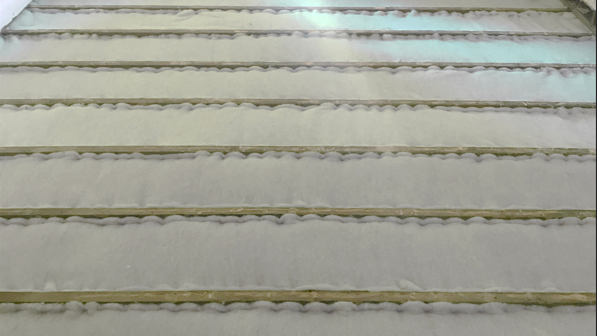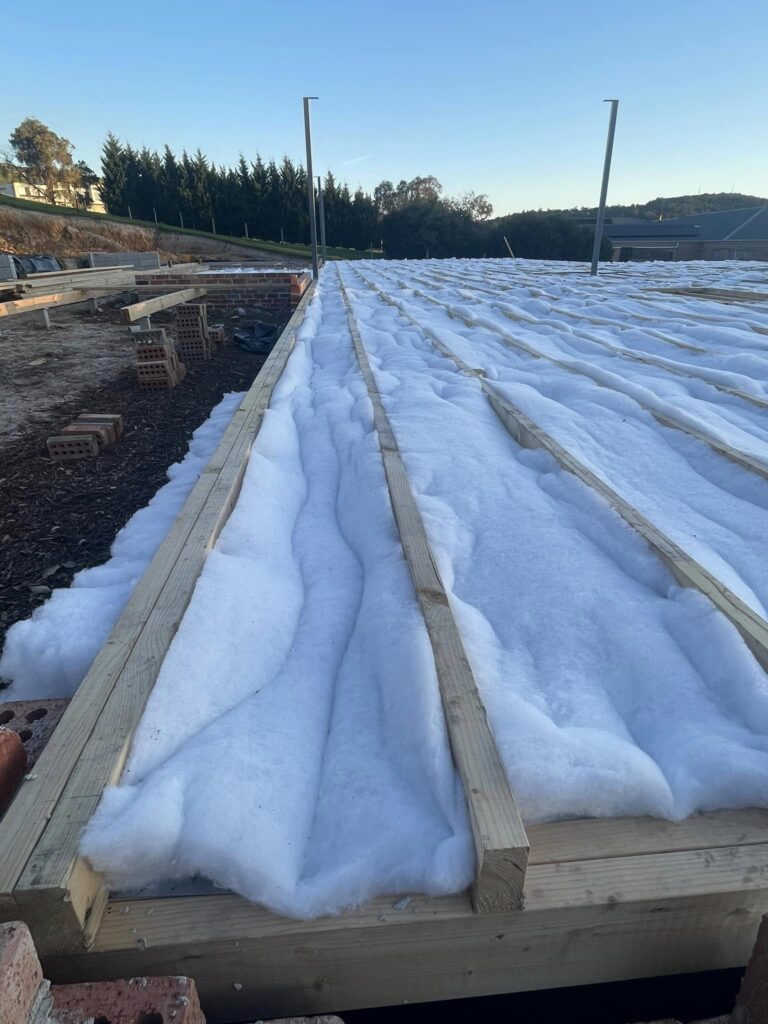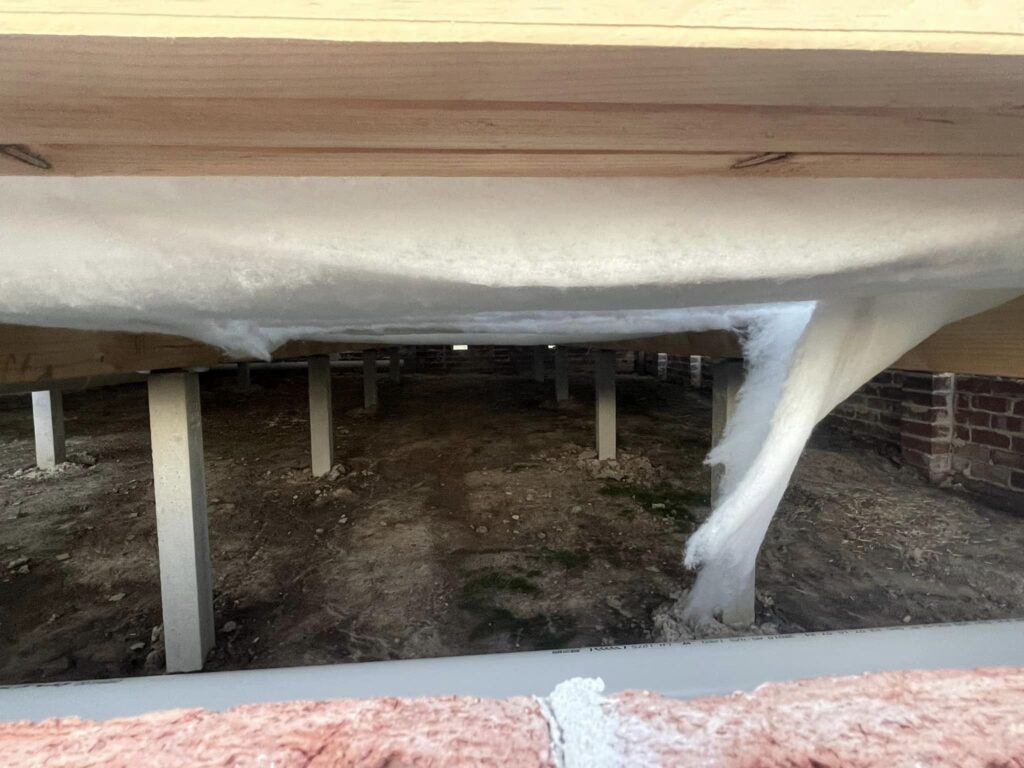
ecoMaster has installed more underfloor insulation than any other company in Australia. We were instrumental in helping to develop roll form polyester for underfloor applications – it was one of our specialties. We worked in all situations: from REALLY tight underfloor spaces to pole homes that required scaffolding so that we could reach the floor, to installing insulation in homes that were being fully renovated and the floors were lifted so we could fit from inside the home.
This article outlines how you would install insulation in a home where the floorboards have either not been put in place yet, or have been temporarily removed. We called this “Fit from the Top” or “Fit from Above”.
WHY USE POLYESTER?
Hands down, polyester is the best insulation to use for underfloor insulation. Its hydrophobic qualities (water resistance) are particularly important in a new build where the floor is being installed and no roof protection is in place yet. If it rains during the installation process, any insulation other than polyester will need to be removed and replaced.
If polyester insulation gets wet, it will just dry out with no risk of mould or mildew developing when the floorboards have been fitted. Just that feature alone, makes polyester insulation the ‘go to’ insulation for homes under construction; and particularly so for owner builders.
Only Polyester can be stapled in place. All of our underfloor rolls have their polyester fibres aligned across the roll. There are polyester rolls and batts with randomly arranged fibres but we have never used them in clients’ homes and we don’t supply them.
Why is it important to have aligned fibres?
- It means you can staple the material with confidence that the fibres won’t simply tear out in chunks.
- It is very easy to tear across the roll in a neat manner. That makes “turn and tear” a breeze. This is the method of fitting polyester insulation to non-standard joist spacing.
WHAT WIDTH OF INSULATION SHOULD I ORDER?
The width of the insulation you need to order should be the width of your joist spacing plus 10mm each side for stapling. So the optimal width of insulation to order for a 430mm joist spacing is 450mm.
If the spacing between the joists is 410mm, then you would be looking to order insulation that is 430mm wide, or be prepared to trim it to that width.
Where joist spacings do not facilitate a natural “along the joist” fit, professional installers “turn and tear” polyester insulation so it is fitted across the joists rather than along them. “Turn and tear” results in more joins but less material wastage. [Learn more]
If you have non-standard joist spacings, and don’t want to turn and tear, then you can cut the insulation lengthwise with an angle grinder using a 1mm thick cutoff disc, so it will fit the space between the joists without being squashed. Watch the video here.
TWO METHODS OF INSTALLATION:
Fitting insulation from the top generally implies that you will not be able to access it from underneath in the future. This means that it is critically important that your method of securing your underfloor insulation lasts as long as your insulation. Polyester has a warranty period of between 50 and 70 years, so its method of securing needs to last the same timeframe.
There are two potential methods of installation when fitting from the top. Both have advantages and drawbacks. They are:
- Fitting a supporting membrane under the joists and then simply dropping the insulation in. We have not ever done this nor seen it done.
- Stapling the insulation along the top of the joists. This is the method that we have used when fitting underfloor insulation from the top.
SUPPORTING MEMBRANE METHOD:
Some people feel that this is potentially a better method of installation. To be fair, the idea of simply dropping the insulation in has great appeal. But, as always, the devil is in the details, and in this case it’s the difficulty and potentially expense of providing a taught and tough supporting membrane under the existing joists.
Potential materials would be things such as rolls of breather reflective foil, or maybe a plastic barrier mesh (the kind of orange safety mesh typically set up in a temporary fashion between bollards.) Sometimes packing strapping or even nylon fishing line has been considered for supporting insulation.
The first thing to say here is that any random form of support, such as packing strap or nylon line, is to be discouraged. There will never be enough supports installed to hold all of the insulation firmly against the new floor. At best you will get patchy insulation cover and at worse you will be inviting rodents into the unsupported parts.
The more substantial membranes are potentially a viable solution. The difficulty here is in securing them across under the joists in a taught and complete manner. Perhaps these can be stapled up to the underside of the joists or perhaps they can be glued up with a “stick once” style of adhesive such as Fullers Toolbox that we use for Joisties (underfloor insulation for steel joists). Strong stuff!
Whatever the method, the last run is going to be the most difficult because now you will need to balance on top of the joists and somehow fit the final run of membrane across the room. Perhaps the best idea is to leave the last 300mm or 400mm without membrane so you can still stand on the ground to fit the last section. You can potentially tuck the last part of the polyester roll into the last bearer or glue the last little bit of the polyester roll to the side of the joists.
As you can see, this method is possible but does incur additional expense, significant labour and careful working out of the details.
STAPLING METHOD FOR POLYESTER INSULATION:
Stapling the insulation along the top edge of the joists is similar to stapling it to the bottom of the joists in a regular retrofit method. The main difference is that stapling from the top leaves a small gap between the insulation and the new floor. This is addressed below.
Staples should be used every 100mm to 150mm to secure the insulation effectively. More staples are better than fewer. Here are some things to consider:
- If the insulation is bunched up, it means that the width of the insulation is too wide for the width of the space between the joists. That will encourage vermin to party in the gaps that have been created.
- When fitted from the top, the insulation must not bunch up and must be pulled tight and stapled securely along the joist (as per the image).
- In most instances there will be at least some “turn and tear” required. You can see that in the foreground of the image below.
- Vermin don’t like polyester – they won’t eat it, nor will they take it away.
- To avoid a vermin party, ensure that the insulation completely fills the entire space from the yellow tongue or timber floorboards down to where it is stapled. This happens naturally when the material is stapled from the bottom of the joists.
- You will need a board to kneel on in order to fit the last run of insulation in the room.
- Stapling from above dishes the material slightly away from the floor level. Once all of the insulation is stapled in securely, it’s time to infill the voids. To do this, tear small sections off a roll and delaminate them (split into 2 or more thinner sections) and place over the stapled insulation to fill the dish to slightly more than floor level. That way, when the floor is installed it will slightly compress the insulation and ensure a full and complete thermal performance and vermin proof cover.
CAN I STAPLE FIBREGLASS UNDER MY WOODEN FLOORS?
No. you can’t staple fibreglass (like earthwool, pink batts or gold batts) because the glass fibres are too small and too brittle to hold a staple.
CAN I FRICTION FIT INSULATION?
Technically yes, you can “friction fit” insulation between the joists. Friction fit means installing insulation without any kind of support whatsoever and hoping that the timber joists will hold the insulation in place. However, the vibration of the floor from people walking, dancing, kids jumping or moving furniture will surely dislodge the insulation over time and it will end up useless and ineffective, on the ground under your inaccessible underfloor. Please don’t do this.
MORE INFORMATION:
We have a masterclass on underfloor insulation if you would like to learn more about underfloor insulation from the people who have installed more underfloor insulation than anyone else. Check it out.
This masterclass was based on 20 years of insulation selection and installation distinctions. We have seen some real disasters in our time. Please don’t be one of them [Learn more]
The images below demonstrate how NOT to install insulation in a “fit from the top”. There are a few installation issues that we can highlight here:
- The insulation is too wide for the joists, so it is bunched up which is compressing the insulation. It will not be able to perform at the appropriate R value.
- Not enough staples have been used to secure the insulation along the top of the joists. You can see the impact of this in the right-hand photo showing that the insulation is sagging down already.
- There is too much space from the top of the insulation to where the floor will be placed. This creates a haven for vermin to exploit.
- The insulation has been torn during installation and is already hanging down. That provides no benefit to the householder at all.


This installation was done by a qualified builder!! We supported the householder with rectification support!!
People Also Ask:
⇒ Can Underfloor Insulation Cause Damp?
That is an excellent question to ask! Underfloor insulation does not cause dampness, or condensation. If you have damp issues under your floor, underfloor insulation will not fix them. You will need to find the root cause and fix that first. It is important that during installation, you do not block the ventilation grills/air bricks that provide air change under the floor area. Without ventilation under your floor, the air can become stagnant and trap moisture which itself can lead to dampness and mould.
⇒ What type of insulation is best for underfloor?
Our team discovered using many different types of underfloor insulation, that polyester rolls were actually the best type of insulation under a floor. Some of the reasons are that it insulates the floor so it is the same temperature inside as it is outside, eliminates draughts coming through the floorboards, will not be impacted by water if there is a spill in the home, is not attractive to rodents at all, can be pulled down and reinstated without damage if the floor ever needs to be accessed, is made from recycled plastic bottles which is great for the environment and is not made from glass splinters so it is not itchy and is not toxic.
There are many who think that polystyrene insulation boards are the best fine of insulation. However, having installed more underfloor insulation than any other business in Australia, we are not inclined to share that view. These are just a few reasons why:
- Polystyrene boards, being inflexible, are incredibly difficult to manage under a tight floor, and even getting them through the access point can be really challenging,
- Many floors have joist spacings that are variable, so fixed boards would need to be cut specifically for each joist, and we millimetre perfectly cut as well to ensure that rodents did not create super highways under your floor
- The R rating of polystyrene boards is much lower than that of polyester insulation
- If the polystyrene has foil attached, that can be quite problematic if it comes into contact with electrical wires.
What’s Next?
We hope this article has helped you learn how to use simple ways to save on your utility bill. This in turn will help you on your energy and thermal efficiency retrofit journey to make your home more comfortable all year round, and reduce your costs and carbon emissions.
Next, explore the Top 3 things you must know about termites and underfloor insulation.
If you found this article helpful, then please subscribe to our YouTube Channel. You’ll find many more helpful “How To” videos there. You can also follow us on Facebook and Instagram to stay in the loop. For more great information on how to make your home more energy and thermally efficient subscribe NOW to ecoBites. ecoBites are free bite size chunks of the latest energy efficiency information making it quick and easy for you to absorb.

If your floor is open, it’s a perfect time to “fit from the top”
Polyester Underfloor Insulation


Recent Comments